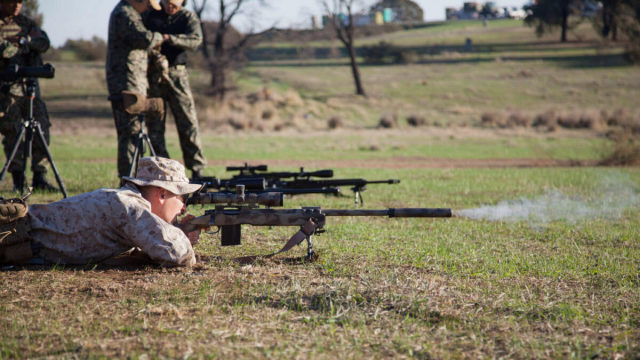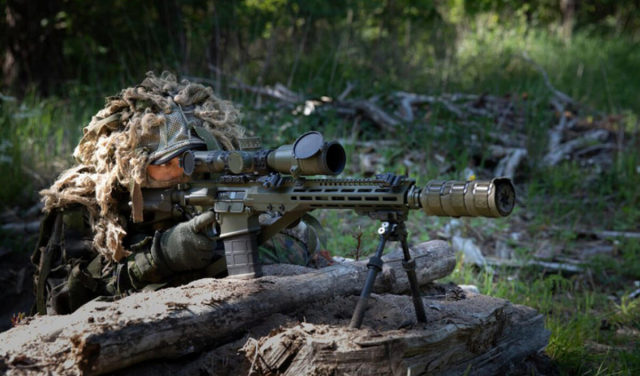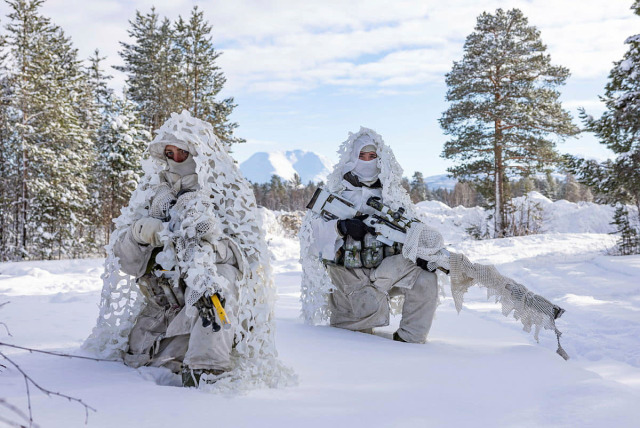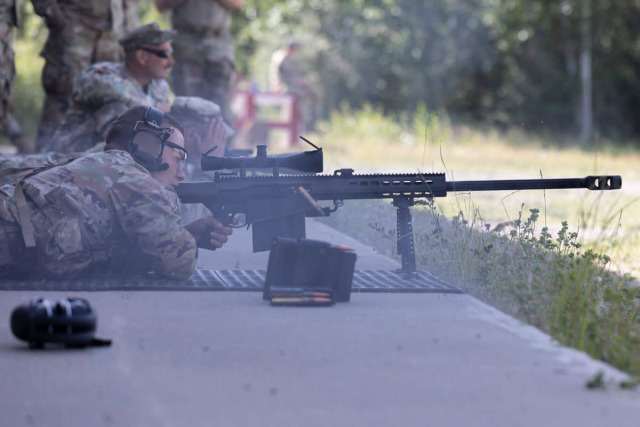Once upon a time, sniper shooting was a much less challenging task than it is today. The reason lies in the expansion of the characteristics of sniper rifles and auxiliary optics to previously unattainable levels. In turn, this led to a significant change in the sniper's mission and, in parallel, to an increased understanding of the operational advantages that a high-quality sniper potential gives in terms of detecting, defeating and neutralizing targets. In addition, sniper shooting has also evolved, becoming a valuable reconnaissance tool for ground commanders.
Author: David Saw is a defense specialist writer living in Paris, France. He has a long and comprehensive experience of publishing articles in defense journals of the highest level in the USA, Europe and Asia.
Before discussing what sniper shooting is today and the tools necessary for its success, it is necessary to briefly talk about the modern sniper environment and how it has developed. Previously, sniping was associated exclusively with the operator, weapons, optical sight and related ammunition. Since marksmanship was considered a central element of soldier training, it provided an ideal framework for identifying those with the potential to become a sniper. Then this group underwent additional specialized training, and after selection, the basis of a sniper was born in you.
It was also necessary to choose a weapon for a sniper, and for a considerable period of time it was really not a difficult process. During the production of the standard service rifle, bolt-action weapons were used for many years, the best and most accurate samples were selected and put aside for use by snipers. At this stage, a sight attachment point and an optical sight were added. Suitable or other high-quality ammunition was then provided and your sniper abilities were ready to be used.
The evolutionary path of sniper shooting
This, of course, was the approach of the British army, but when the 7.62×51 mm cartridge became the standard NATO cartridge, the British decided to modify their existing sniper rifles No.4 Mk.1 (T) and Mo.4 Mk.1*(T) from the 7.7×56 mm RR to adapt to the new NATO cartridge, and then added other modifications to create the L42A1 sniper rifle. In contrast, the US Army decided to create a sniper system based on its then-new M14 7.62×51 mm assault rifle. During production, exceptionally accurate M14 rifles were selected, which served as the basis for the M21 sniper rifle. They were switched to semi-automatic operation, their equipment was changed, a mount for the sight and an optical sight were installed.
The United States Marine Corps (USMC) has taken a different approach to meeting its needs for sniper rifles, choosing the Remington 700 bolt-action rifle as the basis for the M40 sniper rifle of 7.62×51 mm caliber. The rifle has a Mauser mechanism and is based on the P14 rifle, which Remington produced for the UK during the First World War. Later, the US Army replaced its M21 sniper rifles with the M24, which were essentially the Remington 700.

Snipers of the USMC with their M40A5 7.62×51 mm sniper rifle at the training ground in the Pakpunyal Military District, Victoria, Australia. The M40 is based on a modified Remington Model 700 rifle originally developed in the 1960s. The M40 remained the standard KMP sniper rifle for over 40 years.
Rifles were considered effective weapons, but compared to what can be achieved with modern sniper systems, they were actually somewhat limited. When the British army was looking for a replacement for the L42A1, the competitive evaluation of the successor weapon was based on the compliance of the characteristics of the L42A1 with basic requirements: an effective firing range of 600 m and disturbing fire at a distance of up to 800 m. Today, the Australian Army EF88 rifle of 5.56×45 mm caliber, equipped with a Raytheon Elcan Spectre DR 1-4x optical sight, has such accuracy that when using standard cartridges, the firing range now reaches 600 m. This shows the difference that modern optics can make.
When using special M118 cartridges, the effective firing range of the M21 of the US Army was 690 m, while the M40 of the US Marine Corps with the same cartridge is capable of reaching 800 m. The chosen successor of the British L42A1 was the Accuracy International (AI) model, which received the designation L96A1. Perhaps the first truly modern L96A1 sniper rifle of 7.62 ×51 mm caliber could effectively hit targets at a range of up to 900 m and conduct disturbing fire at a distance of up to 1100 m.
At some point, there was a noticeable increase in demand for higher performance and improved effects of hitting the target, which led to a sharp increase in the offered calibers. There has always been an abundance of large-caliber cartridges on the market with various levels of efficiency, for example, for hunting big game. Then there was a competitive shooting, during which specialists also experimented with new rifles and ammunition.
The application of what was known in the commercial sector to the military market led to the emergence of a new category of sniper systems. The American company Barrett Firearms became the leader with the idea of developing a 12.7×99 mm (.50 BMG) semi-automatic rifle for long-range combat, the use of anti-tank weapons and the neutralization of explosive objects. By the end of the 1980s, the final design appeared in the form of the M82, followed by the serial M82A1 system.
The Swedish Army was one of the first to embrace this evolution of sniper capabilities when, in 1989, they ordered about 100 M82A1 rifles from Barrett. Later, the Swedes wanted to purchase a new 7.62×51 mm sniper rifle, which led them to evaluate the British L96A1 from AI. The Swedish Army also asked AI to make changes to the rifle to meet the requirements of their operational environment, which led to the development of the AI Arctic Warfare (AW) sniper rifle.
The Swedish order for the M82A1 really marked the beginning of a wider introduction of 12.7×99 mm anti-material / sniper weapon systems. Then the USMC adopted the M82A1, and the US Army and Air Force followed suit. Other manufacturers also produced 12.7×99 mm caliber weapons. AI developed the L121A1 (AW50), and later AX50. Barrett continued to develop a number of large-caliber solutions, including the McMillan TAC-50. The Austrian Steyr and the French PGM have their own large-caliber systems.
Many others have also appeared, and more exotic variants of various calibers have become available. In Azerbaijan – the system “Istiglal” caliber 14.5 × 114 mm. South Africa has adopted the NTW-20 antimatter system with a caliber of 20×83.5 mm, and the second version of this weapon has a caliber of 14.5 ×114 mm. The 20 mm version has a firing range of more than 1500 m, while the 14.5 mm version has a firing range of more than 2300 m.
Ammunition development
With the advent of the 12.7×99 mm weapon, operators received a system with a range of 1800 m or even more. Since these weapons were purchased in large quantities, there were significant changes in terms of ammunition, and cartridges with a standard bullet were quickly supplemented with more exotic ones. These ammunition improvements are reflected in the wide range of 12.7×99 mm cartridges offered by manufacturers such as Nammo for use in anti-material/sniper weapons.
Nammo's available 12.7×99 mm ammunition includes a bullet, a tracer cartridge, a bullet cartridge with a marker/gunner function (flash) and a bullet cartridge with an IR tracer for night fighting. There is an armor-piercing incendiary cartridge (API), which provides penetration of 22 mm in the equivalent of homogeneous armor (RHAe) at a distance of 700 m for use in antimaterials, as well as a number of multipurpose ammunition. For example, the NM140F3 multipurpose cartridge provides high range and fragmentation effects. There are also multifunctional cartridges with a tracer and with an IR tracer. Along with this, cartridges with a reduced firing range are available for training and operations where it is desirable to reduce efficiency.

The Finnish Defense Forces chose the Sako M23 7.62×51 mm caliber as their TKIV 23 sniper system, equipped with a Steiner M7XI 2.9-20×50 optical sight on a Spuhr mount with a silencer from Ase Utra. Another version of the M23, the KIV 23, is selected as a special sniper rifle.
Sniper shooting continued to evolve as new calibers of ammunition offering enhanced performance became available. The most popular of the ‘new’ caliber sniper rifles.338 Lapua Magnum (8,6×70 mm), while others chose a different path. For example, in Germany, where the cartridge was used.300 Winchester Magnum (7.62×67 mm), in addition to cartridges.338 Norma Magnum (8.6×64 mm) and reduced versions (up to .300 caliber) of Norma Magnum and Lapua Magnum cartridges are available Norma Magnum and Lapua Magnum cartridges. It should be noted that the basic for .The 338 Lapua Magnum apparently had a cartridge.416 Rigby, designed for hunting in 1911.
Depending on preferences, there are a huge number of hunting cartridges and cartridges designed for competitive shooting at long distances that can be considered for sniper use. Operators of military, paramilitary and police special units can often use these cartridges to create individual sniper solutions, since specialized ammunition is produced in limited series, new barrels can be made of the desired caliber, and both are integrated with the body of the sniper system.
Performance Utilization
Earlier in this article, it was mentioned that the British Army replaced the L42A1 sniper rifle with the L96A1, describing the latter as the first truly modern sniper rifle. If the L42A1 could effectively hit targets at a range of up to 600 m, then the L96A1 could already hit targets at a range of up to 900 m. The appearance of new weapons of larger caliber and improved types of ammunition has led to a sharp increase in the operational characteristics of sniper weapons.
The South African NTW-20 system certainly meets the requirements for the use of antimaterials, although its 20×83.5 mm cartridge was originally developed in Germany in the 1930s for the MG 151 aircraft gun. Another version of the system, the NTW-14.5, with a caliber of 14.5 ×114 mm, turned out to be a much more flexible weapon system – this a material protection system, but also a classic sniper system. In August 2013, a South African sniper seconded to the UN mission in the Democratic Republic of the Congo from an NTW-14.5 neutralized a target at a range of 2,125 m.
The Barrett M82A1 rifle has certainly proven itself in Iraq and Afghanistan. In Iraq, in October 2004, an American sniper fired a successful shot at a distance of 2300 m, while in April 2012 in Afghanistan, an Australian sniper successfully hit a target at a range of 2815 m. The McMillan TAC-50 caliber 12.7 × 99 mm also demonstrated exceptional characteristics as a sniper weapon of the Canadian armed forces. In March 2002, in Afghanistan, Canadian snipers successfully hit targets at a distance of 2310 m and 2430 m. In May 2017, in Afghanistan, a Canadian sniper from a TAC-50 neutralized a target at a range of 3540 m. Most recently, in November 2022, a Ukrainian sniper using a local 14.5×114 mm XADO Snipex Alligator rifle hit at a range of 2710 m.

A two-man British sniper group from the 2nd Battalion of the Parachute Regiment at the Joint Viking exercise near Bardufoss, northern Norway, March 2023. Accuracy International L115A3 caliber sniper rifle .The 338 Lapua Magnum is equipped with a Schmidt & Bender 5-25×56 optical sight. Shown here with a silencer.
Long-range fighting is not limited to large-caliber sniper weapons, as proved by a British army sniper in Musa Qala, Afghanistan, in November 2009. When using an AI L115A3 caliber sniper rifle .338 Lapua Magnum with a Schmidt & Bender 5-25×56 optical sight, a successful shot was recorded at a range of 2475 m. The L115A3 can also provide long-range firing at night or in conditions of limited visibility, since its optical sight can be integrated with both image enhancement systems and thermal imaging systems. British snipers work in groups of two people equipped with optical sights, laser rangefinders and other systems to improve target detection and destruction from their existing equipment.
Productivity growth
Listing these successful long-range shots shows how much the characteristics of sniper systems have increased in recent years. The flexibility of sniper systems has also increased, and this is evidenced by the first tranche of the 159 Lethality Systems project of the Australian Army (ADF) for the acquisition of new small arms. Part of this project was the new ADF sniper system, which provided for the acquisition of anti-personnel sniper shooting capabilities of medium and long range, as well as anti-material sniper shooting capabilities. The last requirement was to replace the Barrett M82A2, and for this purpose the Barrett M107A1 with a caliber of 12.7 × 99 mm was chosen.
To meet other sniper requirements, ADF took advantage of a new trend in sniper rifle design, according to which the rifle can be retrofitted with barrels of various calibers. As a result, the AI AX-SR was selected, allowing you to choose between 7.62×51 mm, .338 Norma Magnum (8.6×64 mm) and .338 Lapua Magnum (8.6×70 mm). This solution provides flexibility in the performance of tasks, and also allows you to conduct training with live firing from the most economical caliber.
Other areas where the flexibility of sniper systems has been enhanced are the field of sighting systems. Optical characteristics have grown exponentially. The systems offer obvious operational advantages, which also means that more and more people can meet the basic criteria for sniper qualification. Sniper shooting is much more than being the best shooter, as a sniper must be extremely tactically astute to take a position to hit the target and then move to a new location after the shot. The sniper is also a valuable source for intelligence, because you can see much more through sniper optics, and when moving around the terrain, knowing important information and passing it along the chain of command is also important for completing the mission.
The technology will add more opportunities to support and expand the capabilities of snipers. As noted earlier, sniper sights are integrated with image amplifiers and thermal imaging sights, laser rangefinders, meteorological sensors are used, often with ballistic calculators included. British sniper teams use a Leupold Mark 4 12-40×60 mm tactical optical sight and a manual thermal imaging surveillance sight.

The M107A1 12.7×99 mm weapon is described by the US Army as a ‘precision rifle'. Here it is shown in July 2023 at a landfill in Alaska. The M107A1 has been selected by the Australian Defence Force (ADF) to match the materiel sniper protection capability segment in their new sniper system.
However, integration of a sniper rifle with a digital fire control system is potentially possible in the future. The US Army's next-generation XM7 rifle (formerly known as XM5) and the XM250 automatic rifle, essentially a squad support weapon, will be equipped with the Vortex Optics XM157 (FCS) fire control system, which has an optical sight, a laser rangefinder, visible and infrared aiming lasers, a ballistic calculator, a set of meteorological sensors and a digital display.
The Canadian company Raytheon Elcan has also developed a digital fire control system in the Spectre Digital Fire Control Sight (DFCS), and the ground forces of several NATO member countries have expressed interest in evaluating this system.
It is logical to assume that in the future the sniper rifle will be integrated with a complete FCS solution. The technology to achieve such a solution is basically already available. All that remains is the integration task to create a sniper–oriented FCS solution.
The materials of the article contain exclusively author's estimates and do not reflect the position of the editorial board of IVi
Based on the materials of the European Security & Defense magazine
